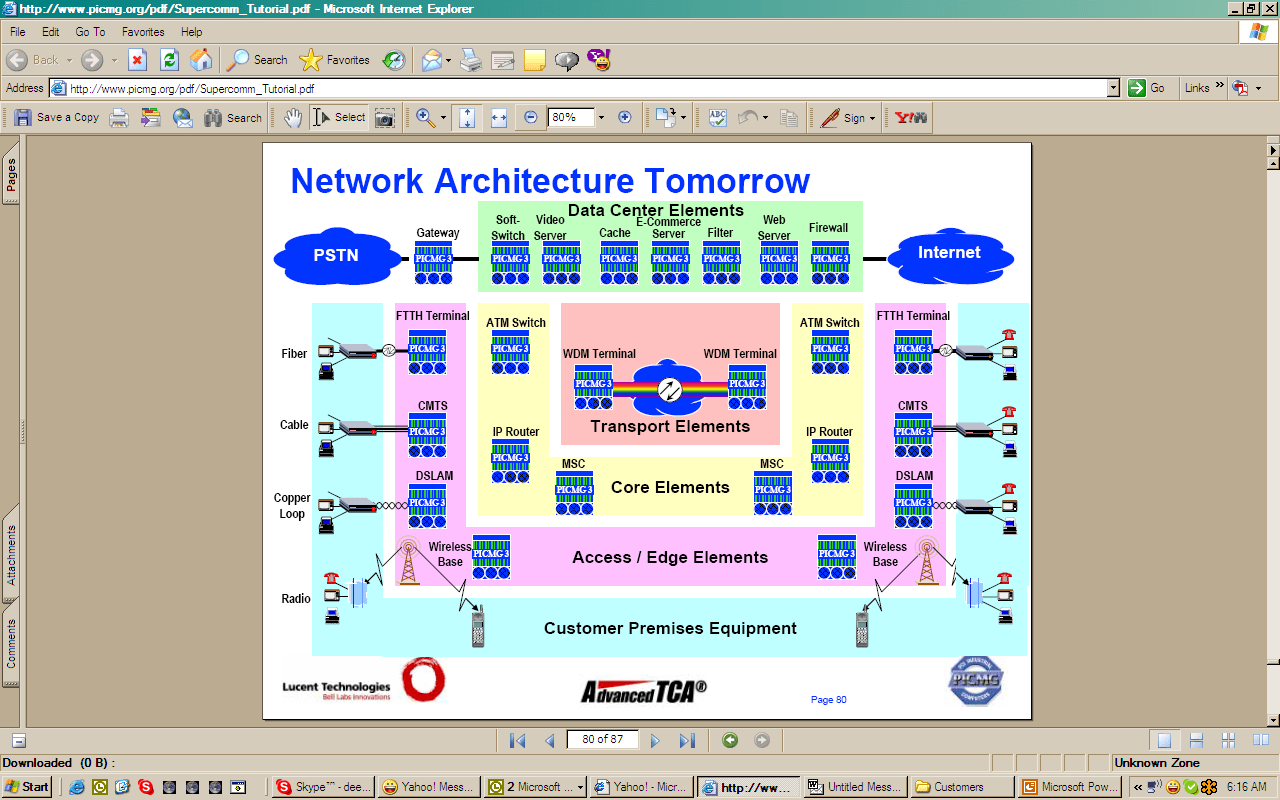Advanced Telecom Computing Architecture, AdvancedTCA or ATCA, is a series of industry standard specifications for the next generation of carrier grade communications equipment, including new blade (board) and chassis form factor (shelf) optimized for communications. ATCA is being developed by the PCI Industrial Computer Manufacturers Group (PICMG) and is designed to meet the requirements of next-generation communication applications that cannot be served by existing solutions such as CompactPCI or proprietary solutions. Over 100 companies are part of the ATCA effort, including network equipment providers, computer OEMs, Applied Computing Providers, and third-party hardware and software vendors.
Mirabilis Design™ provides collaborative systems engineering software applications and services to enable concept engineering for electronics and real-time software suitable for prototyping ATCA. Mirabilis Design’s software product, VisualSim, optimizes product architectures by running simulations with application profiles to trade-off IP selection; make vs. buy decisions; power vs. performance; and partitioning behavior on target architectures. The simulation is run on models of the hardware and software that are quickly developed using pre-built, parameterized modeling libraries in a graphical environment. Mirabilis Design accelerates architecture exploration by drastically reducing typical model development from months to days.
AdvancedTCA standardization creates a substantial market opportunity in a number of product and application areas as shown in Figure 1. The AdvancedTCA standard requires startup companies and market leaders to create competitively differentiated elements that support the standard in terms of topology variations, protocol support, interface definitions, and intra-element communication. Differentiation might be higher effective throughput, lower power, and single product, multiple application solutions. All these should be available at the lowest price-point, highest sustained QoS and within a power budget. As AdvancedTCA has standardized the interfaces, bus topology, processor interfaces and speeds, differentiation must come in the form of innovative use of technology and the ability to quickly adapt to new applications. Or simply, quality designs at the lowest price performance points in the shortest time.
Now the real question is, without over-sizing, how does one create the lowest cost, highest QoS and minimal power consumption for the widest range of applications?

Figure 1. ATCA Applications (Courtesy Lucent Technologies, Advanced TCA and PICMG)
Architects of AdvancedTCA elements have a number of design challenges that could be used to their advantage if approached with a modeling methodology. As the standard evolves and technology shifts occur, architects must keep their designs updated and support the growing application requests from telecommunication and data center customers. The shrinking time between release of the standard and product availability requires companies to be quick to market.
To differentiate their products, architects must determine the optimal combination of hardware and software processing, yet retain a simplicity in installation, operation, and maintenance. For example, a key throughput differentiation might be the ability to distribute repetitive protocol, data transfer tasks across an Advanced Switching system. Should this data transfer be performed using one or more lower cost processor chips? Should the decision be based on power, cost, performance, or combinations thereof? On the software side, what might be the optimal thread allocation across a multi-processor, multi-core processor system?
Early partnership with customers using visual prototypes will improve quality feedback on early design decisions, improving time-to-market. For example a new startup developing mezzanine cards for Micro-ATCA could demonstrate the interoperability of their specific designs using virtual prototypes, months before a pre-production version is available. Moreover if the customer has additional applications in mind, this visual prototype might be quickly enhanced to provide instant feedback on the Quality of Service (QoS) for a new feature.
A typical VisualSim modeling application was described by an engineering manager at a major real-time software company who said, “In a multi-protocol switch project, we developed our software for a specified processor board before it was built. After software was written and the board delivered, we found out that the processing was too slow. So we spent the next 6 months de-featuring the software to make it work fast enough. It would have been great if we could have known about this before we started our development. Can your software team provide early insights into the hardware-software interactions, resource processor utilizations, including instantaneous power, for various tasks?”
VisualSim provides these insights using rapid visual prototyping.The VisualSim environment enables an engineer to start with a hierarchical layout of the block diagram of the proposed system. Next the performance and behavior details are added to each hierarchical model block. A separate definition of the hardware and software architecture is constructed. The hierarchical blocks are mapped to the architecture components as possible implementation scenarios. This virtual prototype is optimized by varying parameter attributes of the design and simulating to explore power and performance. The validated model generated through this process is used as the golden specification document for scheduling implementation. This virtual prototype completes the design loop by replacing concept-level modules with hardware and software implementation blocks, as they become available, for system-level verification. The optimized simulation model is embedded into engineering documents. This dynamic executable specification becomes the collaborative design platform for communicating the requirements and specification and, handling future changes.
Examples of architecture exploration conducted using VisualSim include optimal bus, memory and processor speeds, type of memory, switching, buffering, caches, packet sizing, latency, contention and routing latency, DMA sizing and memory arbitration, protocol conversion, replacement policies, control, and multi-processor selection and load balancing.
ATCA has tremendous potential and a large array of possibilities. Differentiation based on technology and the reuse of the platform is vital to succeed in this market. Visual Prototyping provides a vital link in enabling rapid design exploration, early design-win and a collaborative platform for product development with partners and customers. VisualSim from Mirabilis Design provides the required graphical modeling environment, components and functionality definition libraries, workload generators and analysis tools. The ability to perform early exploration has also been demonstrated to reduce the verification effort and the time-to-market for complex system products.